STARTING SYSTEM: COMPONENTS AND HOW IT WORKS

The starter motor is an electric motor that rotates your engine in order to allow the spark and fuel injection systems to begin the engine’s operation under its own power. Typically, the starter is a large electric motor and stator coil mounted to the bottom (generally to one side) of the vehicle’s transmission bell housing where it connects to the engine itself. The starter has gears which mesh with a large flywheel gear on the back side of the engine, which turns the central crankshaft. Because this is a lot of physical weight and friction to overcome, starter motors are generally powerful, high-speed motors and use an ignition coil to ramp up their power before engaging.
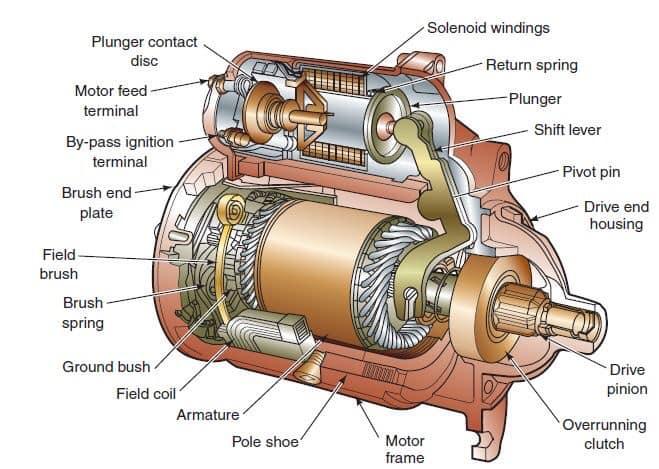
Components of the starting system
1. Battery
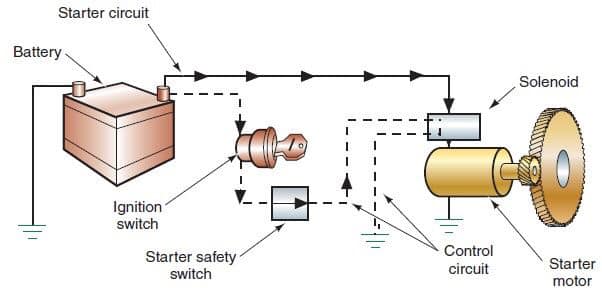
The automotive battery, also known as a lead-acid storage battery, is an electrochemical device that produces voltage and delivers current. In an automotive battery, we can reverse the electrochemical action, thereby recharging the battery, which will then give us many years of service. The purpose of the battery is to supply current to the starter motor, provide current to the ignition system while cranking, to supply additional current when the demand is higher than the alternator can supply and act as an electrical reservoir.
2. Ignition Switch
The ignition switch allows the driver to distribute electrical current to where it is needed. There are generally 5 key switch positions that are used:
1. Lock- All circuits are open ( no current supplied) and the steering wheel is in the lock position. In some cars, the transmission lever cannot be moved in this position. If the steering wheel is applying pressure to the locking mechanism, the key might be hard to turn. If you do experience this type of condition, try moving the steering wheel to remove the pressure as you turn the key.
2. Off- All circuits are open, but the steering wheel can be turned and the key cannot be extracted.
3. Run- All circuits, except the starter circuit, are closed (current is allowed to pass through). Current is supplied to all but the starter circuit.
4. Start- Power is supplied to the ignition circuit and the starter motor only. That is why the radio stops playing in the start position. This position of the ignition switch is spring loaded so that the starter is not engaged while the engine is running. This position is used momentarily, just to activate the starter.
5. Accessory- Power is supplied to all but the ignition and starter circuit. This allows you to play the radio, work the power windows, etc. while the engine is not running.
Most ignition switches are mounted on the steering column. Some switches are actually two separate parts;
* The lock into which you insert the key. This component also contains the mechanism to lock the steering wheel and shifter.
* The switch which contains the actual electrical circuits. It is usually mounted on top of the steering column just behind the dash and is connected to the lock by a linkage or rod.
3. Neutral Safety Switch
This switch opens (denies current to) the starter circuit when the transmission is in any gear but Neutral or Park on automatic transmissions. This switch is normally connected to the transmission linkage or directly on the transmission. Most cars utilize this same switch to apply current to the backup lights when the transmission is put in reverse. Standard transmission cars will connect this switch to the clutch pedal so that the starter will not engage unless the clutch pedal is depressed. If you find that you have to move the shifter away from park or neutral to get the car to start, it usually means that this switch needs adjustment. If your car has an automatic parking brake release, the neutral safety switch will control that function also.
4. Starter Relay
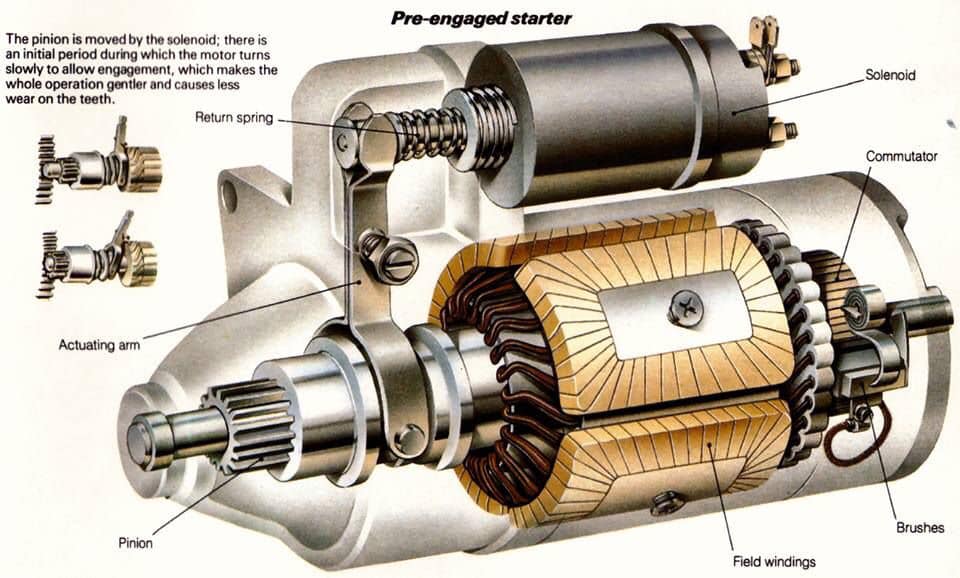
A relay is a device that allows a small amount of electrical current to control a large amount of current. An automobile starter uses a large amount of current (250+ amps) to start an engine. If we were to allow that much current to go through the ignition switch, we would not only need a very large switch, but all the wires would have to be the size of battery cables (not very practical). A starter relay is installed in series between the battery and the starter. Some cars use a starter solenoid to accomplish the same purpose of allowing a small amount of current from the ignition switch to control a high current flow from the battery to the starter. The starter solenoid in some cases also mechanically engages the starter gear with the engine.
5. Battery Cables
Battery cables are large diameter, the multistranded wire which carries the high current (250+ amps) necessary to operate the starter motor. Some have a smaller wire soldered to the terminal which is used to either operate a smaller device or to provide an additional ground. When the smaller cable burns, this indicates a high resistance in the heavy cable. Care must be taken to keep the battery cable ends (terminals) clean and tight. Battery cables can be replaced with ones that are slightly larger but never smaller.
6. Starter Motor
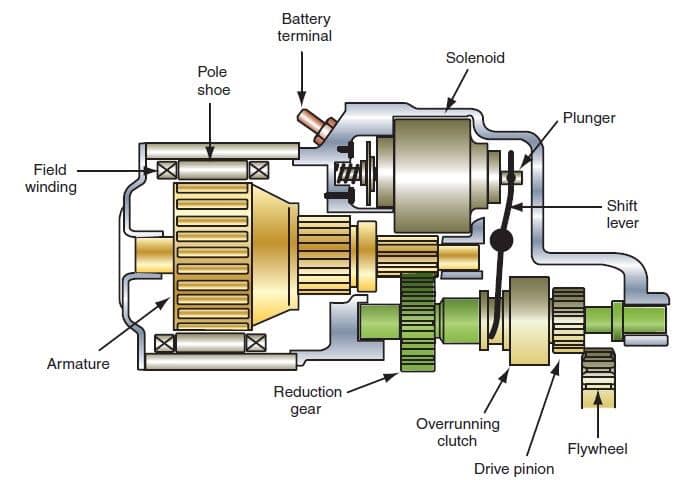
The starter motor is a powerful electric motor, with a small gear (pinion) attached to the end. When activated, the gear has meshed with a larger gear (ring), which is attached to the engine. The starter motor then spins the engine over so that the piston can draw in a fuel/ air mixture, which is then ignited to start the engine. When the engine starts to spin faster than the starter, a device called an overrunning clutch (Bendix drive) automatically disengages the starter gear from the engine gear.
Working principles.
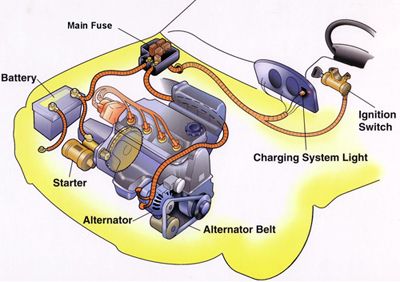
To make an engine start it must be turned at some speed, so that it sucks fuel and air into the cylinders, and compresses it.
The powerful electric starter motor does the turning. Its shaft carries a small pinion (gear wheel) which engages with a large gear ring around the rim of the engine flywheel.
In a front-engine layout, the starter is mounted low down near the back of the engine.
The starter needs a heavy electric current, which it draws through thick wires from the battery. No ordinary hand-operated switch could switch it on: it needs a large switch to handle the high current.
The switch has to be turned on and off very quickly to avoid dangerous, damaging sparking. So a solenoid is used – an arrangement where a small switch turns on an electromagnet to complete the circuit.
The starter switch is usually worked by the ignition key. Turn the key beyond the ‘ignition on’ position to feed current to the solenoid.
The ignition switch has a return spring so that as soon as you release the key it springs back and turns the starter switch off.
When the switch feeds current to the solenoid, the electromagnet attracts an iron rod.
The movement of the rod closes two heavy contacts, completing the circuit from the battery to the starter.
The rod also has a return spring -when the ignition switch stops feeding current to the solenoid, the contacts open and the starter motor stops.
The return springs are needed because the starter motor must not turn more than it has to in order to start the engine. The reason is partly that the starter uses a lot of electricity, which quickly runs down the battery.
Also, if the engine starts and the starter motor stays engaged, the engine will spin the starter so fast that it may be badly damaged.
The starter motor itself has a device, called a Bendix gear, which engages its pinion gear with the gear ring on the flywheel only while the starter is turning the engine. It disengages as soon as the engine picks up speed, and there are two ways by which it does so – the inertia system and the pre-engaged system.
The inertia starter relies on the inertia of the pinion gear – that is, its reluctance to begin to turn.
The pinion gear is not fixed rigidly to the motor shaft – it is threaded on to it, like a freely turning nut on a very coarse-thread bolt.
Imagine that you suddenly spin the bolt: the inertia of the nut keeps it from turning at once, so it shifts along the thread of the bolt.
When an inertia starter spins, the pinion moves along the thread of the motor shaft and engages with the flywheel gear ring.
It then reaches a stop at the end of the thread, begins to turn with the shaft and so turns the engine.
Once the engine starts, it spins the pinion faster than its own starter-motor shaft. The spinning action screws the pinion back down its thread and out of engagement.
The pinion returns so violently that there has to be a strong spring on the shaft to cushion its impact.
The violent engagement and disengagement of an inertia starter can cause heavy wear on the gear teeth. To overcome that problem the pre-engaged starter was introduced, which has a solenoid mounted on the motor.
There’s more to a car starter system: As well as switching on the motor, the solenoid also slides the pinion along the shaft to engage it.
The shaft has straight splines rather than a Bendix thread so that the pinion always turns with it.
The pinion gear is brought into contact with the toothed ring on the flywheel by a sliding fork. The fork is moved by a solenoid, which has two sets of contacts that close one after the other.
The first contact supplies a low current to the motor so that it turns slowly – just far enough to let the pinion teeth engage. Then the second contacts close, feeding the motor a high current to turn the engine.
The starter motor is saved from over-speeding when the engine starts by means of a freewheel clutch, like the freewheel of a bicycle. The return spring of the solenoid withdraws the pinion gear from engagement.

Ante todo un cordial saludo, concidero todos los contenido que comparten de mecánica automotriz muy interesantes pero pudieran traducir este al español.
Saludos
Lo puedes traducir tu mismo